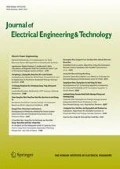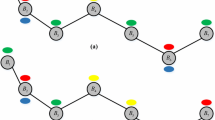Abstract
In this research, Zero Injection Buses (ZIBs) were modeled to minimize the number of Phasor Measurements Units (PMUs) and ensure the full observability of power systems. To determine the operation of the proposed method, all ZIBs that are connected to each other and other buses were presented in models H, M, and D, each of which featured new observability constraints. The H set, is defined as the set of buses that are connected to a ZIB. Also, the \(M\) set is defined as the \(H\) set that is connected through ZIBs. The \(D\) set is defined as the \(M\) set that is connected through ZIBs to a common bus. To increase the assurance of complete power system observability in the method put forward in this work, conditions such as line outage, single PMU loss, and line or PMU exit were examined. To demonstrate the efficiency of the approach, it was applied to 14, 30, 39, 57 and 118 IEEE test systems. The simulation results showed that the developed topologies enhanced network observability under a minimum number of PMUs.




Similar content being viewed by others
References
Khorram E, Mehdi TJ (2018) PMU placement considering various arrangements of lines connections at complex buses. Int J Electr Power Energy Syst 94:97–103
Nanda P, Panigrahi CK, Dasgupta A (2017) Phasor estimation and modelling techniques of PMU—a review. Energy Procedia 109:64–77
Gomez O, Rios MA, Anders G (2014) Reliability-based phasor measurement unit placement in power systems considering transmission line outages and channel limits. IET Gener Transm Distrib 8(1):121–130
Leelaruji R, Vanfretti L, Uhlen K, Gjerde JO (2015) Computing sensitivities from synchrophasor data for voltage stability monitoring and visualization. Int Trans Electr Energy Syst 25(6):933–947
Sulla F, Koivisto M, Seppänen J, Turunen J, Haarla LC, Samuelsson O (2014) Statistical analysis and forecasting of damping in the nordic power system. IEEE Trans Power Syst 30(1):306–315
Goleijani S, Ameli MT (2018) Neural network-based power system dynamic state estimation using hybrid data from SCADA and phasor measurement units. Int Trans Electr Energy Syst 28(2):e2481
Manousakis NM, Korres GN (2018) A hybrid power system state estimator using synchronized and unsynchronized sensors. Int Trans Electr Energy Syst 28(8):e2580
Pal A, Kumar A, Vullikanti S, Ravi SS (2016) A PMU placement scheme considering realistic costs and modern trends in relaying. IEEE Trans Power Syst 32(1):552–561
Pal A, Mishra C, Kumar A, Vullikanti S, Ravi SS (2017) General optimal substation coverage algorithm for phasor measurement unit placement in practical systems. IET Gene Transm Distrib 11(2):347–353
Rashidi F, Abiri E, Niknam T, Salehi MR (2015) Optimal placement of PMUs with limited number of channels for complete topological observability of power systems under various contingencies. Int J Electr Power Energy Syst 67:125–137
Aminifar F, Khodaei A, Fotuhi-Firuzabad M, Shahidehpour M (2009) Contingency-constrained PMU placement in power networks. IEEE Trans Power Syst 25(1):516–523
Mahaei SM, Tarafdar-Hagh M (2012) Minimizing the number of PMUs and their optimal placement in power systems. Electr Power Syst Res 83(1):66–72
Peng J, Sun Y, Wang HF (2006) Optimal PMU placement for full network observability using Tabu search algorithm. Int J Electr Power Energy Syst 28(4):223–231
Nuqui RF, Phadke AG (2005) Phasor measurement unit placement techniques for complete and incomplete observability. IEEE Trans Power Deliv 20(4):2381–2388
Mousavian S, Feizollahi MJ (2015) An investment decision model for the optimal placement of phasor measurement units. Expert Syst Appl 42(21):7276–7284
Aminifar F, Lucas C, Khodaei A, Fotuhi-Firuzabad M (2009) Optimal placement of phasor measurement units using immunity genetic algorithm. IEEE Trans Power Deliv 24(3):1014–1020
Rather ZH, Chen Z, Thøgersen P, Lund P, Kirby B (2014) Realistic approach for phasor measurement unit placement: Consideration of practical hidden costs. IEEE Trans Power Deliv 30(1):3–15
Mishra C, Jones KD, Pal A, Centeno VA (2016) Binary particle swarm optimisation-based optimal substation coverage algorithm for phasor measurement unit installations in practical systems. IET Gener Transm Distrib 10(2):555–562
Basetti V, Chandel AK (2017) Optimal PMU placement for power system observability using Taguchi binary bat algorithm. Measurement 95:8–20
Gao Y, Hu Z, He X, Liu D (2008) Optimal placement of PMUs in power systems based on improved PSO algorithm. In: 2008 3rd IEEE Conference on Industrial Electronics and Applications, pp 2464–2469. IEEE, 2008.
Li W, Deka D, Chertkov M, Wang M (2019) Real-time faulted line localization and PMU placement in power systems through convolutional neural networks. IEEE Trans Power Syst 34(6):4640–4651.https://doi.org/10.1109/TPWRS.2019.2917794
Dua D, Dambhare S, Gajbhiye RK, Soman SA (2008) Optimal multistage scheduling of PMU placement: An ILP approach. IEEE Trans Power Deliv 23(4):1812–1820
Gou B (2008) Generalized integer linear programming formulation for optimal PMU placement. IEEE Trans Power Syst 23(3):1099–1104
Hajian M, Ranjbar AM, Amraee T, Mozafari B (2011) Optimal placement of PMUs to maintain network observability using a modified BPSO algorithm. Int J Electrl Power Energy Syst 33(1):28–34
Khajeh KG, Bashar E, Rad AM, Gharehpetian GB (2015) Integrated model considering effects of zero injection buses and conventional measurements on optimal PMU placement. IEEE Trans Smart Grid 8(2):1006–1013
Gou B (2008) Optimal placement of PMUs by integer linear programming. IEEE Trans Power Syst 23(3):1525–1526
‘MatPower Software Package’. https://www.pserc.cornell.edu/matpower. Accessed online
Abbasy NH, Ismail HM (2009) A unified approach for the optimal PMU location for power system state estimation. IEEE Trans Power Syst 24(2):806–813
Roy BKS, Sinha AK, Pradhan AK (2012) An optimal PMU placement technique for power system observability. Int J Electr Power Energy Syst 42(1):71–77
Esmaili M, Gharani K, Shayanfar HA (2013) Redundant observability PMU placement in the presence of flow measurements considering contingencies. IEEE Trans Power Syst 28(4):3765–3773
Mazhari SM, Monsef H, Lesani H, Fereidunian A (2013) A multi-objective PMU placement method considering measurement redundancy and observability value under contingencies. IEEE Trans Power Syst 28(3):2136–2146
Bei X, Yoon YJ, Abur A (2005) Optimal placement and utilization of phasor measurements for state estimation. PSERC Publication, New York, p 1
Lu C, Wang Z, Ma M, Shen R, Yang Yu (2018) An optimal PMU placement with reliable zero injection observation. IEEE Access 6:54417–54426
Babu R, Bhattacharyya B (2018) An approach for optimal placement of phasor measurement unit for power network observability considering various contingencies. Iran J Sci Technol Trans Electr Eng 42(2):161–183
Abdulrahman I, Radman G (2018) ILP-based optimal PMU placement with the inclusion of the effect of a group of zero-injection buses. J Control Autom Electr Syst 29(4):512–524
Author information
Authors and Affiliations
Corresponding author
Additional information
Publisher's Note
Springer Nature remains neutral with regard to jurisdictional claims in published maps and institutional affiliations.
Rights and permissions
About this article
Cite this article
Niyaragh, S.M.M., Irani, A.J. & Shayeghi, H. Modeling of Zero Injection Buses Based to Optimal Placement of PMUs for Full Observability of Power Systems. J. Electr. Eng. Technol. 15, 2509–2518 (2020). https://doi.org/10.1007/s42835-020-00536-0
Received:
Revised:
Accepted:
Published:
Issue Date:
DOI: https://doi.org/10.1007/s42835-020-00536-0




